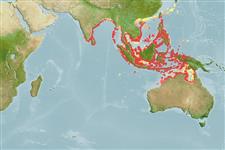>
Eupercaria/misc (Various families in series Eupercaria) >
Lutjanidae (Snappers) > Lutjaninae
Etymology: Lutjanus: Malay, ikan lutjan, name of a fish.
More on author: Cuvier.
Environment: milieu / climate zone / depth range / distribution range
Ecologia
marinhas associadas(os) a recifes; intervalo de profundidade 0 - 50 m (Ref. 128797). Tropical; 31°N - 19°S, 75°E - 142°E (Ref. 55)
Indo-West Pacific: southern India and Sri Lanka to New Guinea, north to the Ryukyu Islands.
Tamanho / Peso / Idade
Maturity: Lm ? range ? - ? cm
Max length : 35.0 cm TL macho/indeterminado; (Ref. 48635); common length : 25.0 cm SL macho/indeterminado; (Ref. 37816)
Espinhos dorsais (total) : 10; Raios dorsais (total) : 13 - 14; Espinhos anais: 3; Raios anais : 8 - 9. This species is distinguished by the following characters: body moderately deep, its depth 2.6-3.1 in SL; preopercular notch and knob poorly developed; vomerine tooth patch crescentic, without a medial posterior extension; tongue with a patch of granular teeth; gill rakers of first gill arch 6 + 8-10 = 14-16. Colour generally whitish, with a `checker-board' pattern on upper half of sides, with dark brown bars and stripes, surrounding rectangular, whitish 'windows'; horizontal brown stripes 5-6, 2 on lower half of sides; caudal fin base with large black spot. (Ref. 9821, 90102)
Adults inhabit both inshore and offshore coral reefs where they occur singly or in schools. Small juveniles on shallow protected reef flats and are used in the aquarium trade.
Ciclo de vida ou comportamento de acasalamento
Maturities | Reprodução | Spawnings | Egg(s) | Fecundities | Larvas
Allen, G.R., 1985. FAO Species Catalogue. Vol. 6. Snappers of the world. An annotated and illustrated catalogue of lutjanid species known to date. FAO Fish. Synop. 125(6):208 p. Rome: FAO. (Ref. 55)
Status na Lista Vermelha da UICN (Ref. 130435)
Ameaça para os humanos
Harmless
Uso pelos humanos
Pescarias: espécies comerciais; Aquário: Espécies comerciais
Ferramentas
Relatórios especiais
Baixar XML
Fontes da internet
Estimates based on models
Preferred temperature (Ref.
123201): 27.4 - 29.3, mean 28.7 °C (based on 1828 cells).
Índice de diversidade filogenética (Ref.
82804): PD
50 = 0.5000 [Uniqueness, from 0.5 = low to 2.0 = high].
Bayesian length-weight: a=0.01778 (0.01097 - 0.02882), b=2.98 (2.85 - 3.11), in cm total length, based on LWR estimates for this species & Genus-body shape (Ref.
93245).
Nível Trófico (Ref.
69278): 4.0 ±0.67 se; based on food items.
Resiliência (Ref.
120179): médio(a), tempo mínimo de duplicação da população 1,4 - 4,4 anos (Preliminary K or Fecundity.).
Fishing Vulnerability (Ref.
59153): Low vulnerability (25 of 100).
Nutrients (Ref.
124155): Calcium = 43.4 [28.7, 62.1] mg/100g; Iron = 0.362 [0.228, 0.547] mg/100g; Protein = 18.6 [17.1, 19.9] %; Omega3 = 0.135 [0.094, 0.190] g/100g; Selenium = 49.8 [33.1, 73.7] μg/100g; VitaminA = 165 [31, 608] μg/100g; Zinc = 0.478 [0.378, 0.666] mg/100g (wet weight);
